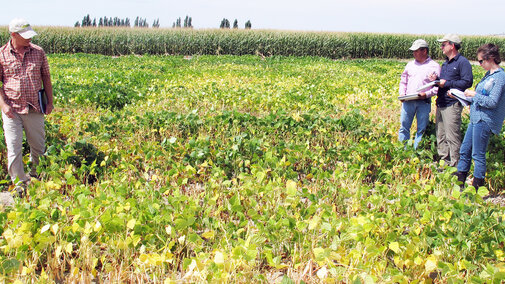On a recent warm, late-summer day, as many dry edible bean growers in Nebraska were watching their fields turn color and preparing for harvest, four scientists paced through a bean field north of Scottsbluff. This field, part of the research acreage at the University of Nebraska’s Panhandle Research and Extension Center, consists of hundreds of tiny plots, each one a different line or type of dry bean representing varieties from all over the world.
These plots are part of a collaborative effort among plant breeders from UNL, other land-grant universities, the US Department of Agriculture, and international organizations such as the International Center for Tropical Agriculture (CIAT) to improve the genetics of dry edible beans grown worldwide.
Dry bean lines are being tested to see whether their genes might be introduced into bean lines sold to Nebraska farmers
- to make their crops more resistant to diseases such as bacterial blight;
- to increase crop tolerance to heat and drought; or
- to produce plants with an upright architecture, suitable for direct harvest by combine.
Other, ever-important traits are early maturation, yield, seed size and seed quality.
Carlos Urrea, dry bean breeding specialist at the UNL Panhandle Research and Extension Center, oversees these plots.
On this day, Urrea and three USDA plant breeders from Washington, Michigan and Puerto Rico were inspecting the plots, looking for plants that showed promise. They look for genetic material that could be introduced into ongoing breeding efforts at Nebraska and elsewhere.
Market classes in these plots include pinto, great northern, small blacks, reds, light-red kidney, yellows, cranberries, and an assortment of others (Calima, Rozi Koko, Kablanketi, etc.) from different continents. The collaborative projects represented include the Western Regional Bean Trials (Nebraska, Colorado, Idaho and Washington); the Midwest Regional Performance Nursery (Nebraska, Michigan, North Dakota, Colorado and Wyoming); the Cooperative Dry Bean Nursery (nine U.S. states, one Canadian province); the shuttle bean breeding nursery with Puerto Rico; and a dry bean drought nursery and white mold monitoring nursery, each involving several states.
Farmers in western Nebraska
grow mainly pinto beans, great northern, and light red kidneys, and smaller amounts of others such as black beans, navies, and chickpeas.Collaboration Key to Breeding Success
When the bean breeders tour cooperative plots such as Urrea’s at Scottsbluff, they look for plants that demonstrate a combination of traits such as moderate to early maturity, good pod set, good yield (more seeds in the pods), uniformity of maturity, and reduced disease, said Phil Miklas of USDA Agricultural Research Service in Prosser, Wash.
As the plot inspection proceeds, Miklas notes that the beans in a particular plot are later in maturity and un-adapted to this region.
“These materials actually were bred in Tanzania and selected in Tanzania. What we’re looking for here are potential gems – materials that have been selected in a wildly, vastly different environment that might bring in some new genetic diversity into the large-seeded kidneys and cranberry beans that we grow in the U.S.”
Miklas notes that each of the four who are touring the fields have projects in east Africa.
“As part of the research community, we share materials and work together and try to help each other succeed in developing better cultivars.” A USAID project designed to help feed people in Africa might also contribute genetic material that helps fight a plant disease in America, he said.
Tim Porch is a research geneticist with USDA-ARS in Mayaguez, Puerto Rico, who has worked with Urrea on the shuttle breeding project for 11 years.
“We select at locations in Nebraska in the summertime and Puerto Rico in the winter time,” he said. “We’re pulling in other sources of drought tolerance from the South American and Central American germplasm. So there are crosses between two races of these smaller seed beans. By doing that we’re expanding the diversity of these seed classes and also bringing in other sources of drought tolerance. Also with climate change we’re bringing in heat tolerance as well. And we’ve been selecting for disease resistance for common bacterial blight at both locations.”
Karen Cichy of USDA-ARS in East Lansing, Mich., is working on a breeding project involving yellow beans.
“They’re a minor market class, but we’re interested in them because we’ve found some of them have a very fast cooking time and we’ve found that they have some interesting nutritional properties,” she said, such as high iron bioavailability. Working with a germplasm collection of 300 yellow beans from a number of market classes (Mayocoba, Canario, Azufrado, etc.), she is trying to breed yellow beans for the United States.
“We’re going to try to understand the genetics of this yellow color and genetics of cooking time and identify good materials that we can use for breeding to get good agronomic characteristics, because a lot of these yellows are susceptible to many diseases. Nebraska is one of three sites we’re testing these genetics at this year.”
She said the U.S. acreage of yellow beans is fairly small compared to market classes such as pintos and kidneys, but there is potential. “They are becoming more popular, especially with Latinos. Different types of yellow are important commercially in Mexico and east Africa.”
The bean-breeding collaborative efforts have been going on for around 50 years, Urrea said. He has been the dry bean breeding specialist for UNL for almost 14 years. The number of dry bean lines tested varies a little from year to year.
The dry beans that researchers are seeing recently have a better plant architecture than 15 years ago, Urrea said. They are more upright, suitable for direct harvest by combine. Some of the beans carry multiple genes for resistance to more diseases than in the past. Over the years, the number of market classes represented in the plots has increased.

